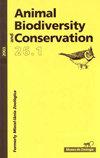伊比利亚北部高原濒危淡水珍珠贻贝种群与非本土物种的关系评估:外来物种多样性的威胁
IF 1
4区 环境科学与生态学
Q3 BIODIVERSITY CONSERVATION
引用次数: 1
摘要
在过去的二十年里,在伊比利亚北部高原的地中海河流中发现了淡水珍珠贻贝(Margaritifera Margaritifera)的小种群。2018年,在卡斯蒂亚和León进行了一项调查,以评估该物种在所有已知分布的河流中的种群发展情况,并更新威胁分类。Negro河、Tera河、Alberche河和Águeda河的30个河段呈阳性,7条河的另外50个河段呈阴性。该物种目前分布在约22.5公里的范围内。Águeda和Tera的数量在过去的14年里急剧减少,处于灭绝的边缘。内格罗河是最大的栖息地,尽管在2004年有栖息地的河段中,至少61%的河段已经消失。所有人口都表现出非常低的密度和老龄化的人口结构,几十年来没有招聘。非本地外来入侵物种(NIS)的存在高于以往的区域调查,其中信号小龙虾是最大的威胁。我们观察了底栖动物微栖息地的变化以及成虫和粘虫的直接捕食。在阿尔伯切河(Alberche River)与M. margaritifera和其他2种贻贝严格同区,共检测到10个NIS。Duero流域目前的水文和生态条件支持外来物种的定居,而本地软体动物对微生境的要求更高。本文章由计算机程序翻译,如有差异,请以英文原文为准。
Assessment of endangered freshwater pearl mussel populations in the Northern Iberian Plateau in relation to non–native species: xenodiversity as a threat
In the last two decades, small populations of freshwater pearl mussels, Margaritifera margaritifera, have been recorded in Mediterranean rivers of the Iberian Northern Plateau. A survey was carried out in Castilla and León in 2018 to assess the development of populations of this species in all the rivers of known distribution and to update the threat classification. Thirty sections in the rivers Negro, Tera, Alberche and Águeda were positive for its presence, and another 50 stretches of seven rivers were negative. The species is currently distributed over about 22.5 km. Águeda and Tera populations have decreased dramatically in the last 14 years and are on the threshold of extinction. The Negro river supports the largest population, although the species has now disappeared in at least 61 % of the stretches that were inhabited in 2004. All populations showed very low densities and an ageing population structure, with no recruitment for decades. The presence of non-native invasive alien species (NIS) was higher than in a previous regional survey, with the signal crayfish representing the greatest threat. We observed changes in benthic microhabitats and direct predation of adults and glochidia conglutinates. In the Alberche River, in strict syntopy with M. margaritifera and two other mussel species, 10 NIS were detected. The current hydrological and ecological conditions in the Duero watershed support the settlement of exotic species to the disadvantage of native mollusks, which are more demanding in terms of microhabitats.
求助全文
通过发布文献求助,成功后即可免费获取论文全文。
去求助
来源期刊

Animal Biodiversity and Conservation
农林科学-动物学
CiteScore
2.00
自引率
0.00%
发文量
21
审稿时长
>12 weeks
期刊介绍:
Animal Biodiversity and Conservation (antes Miscel·lània Zoològica) es una revista interdisciplinar, publicada desde 1958 por el Museu de Ciències Naturals de Barcelona. Incluye artículos de investigación empírica y teórica en todas las áreas de la zoología (sistemática, taxonomía, morfología, biogeografía, ecología, etología, fisiología y genética) procedentes de todas las regiones del mundo. La revista presta especial interés a los estudios que planteen un problema nuevo o introduzcan un tema nuevo, con hipòtesis y prediccions claras, y a los trabajos que de una manera u otra tengan relevancia en la biología de la conservación. No se publicaran artículos puramente descriptivos, o artículos faunísticos o corológicos en los que se describa la distribución en el espacio o en el tiempo de los organismes zoológicos.
 求助内容:
求助内容: 应助结果提醒方式:
应助结果提醒方式:


